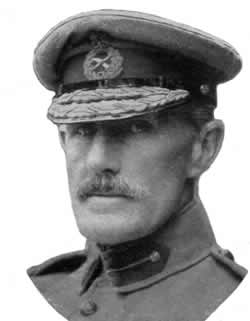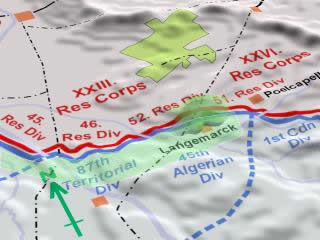 The British observe strange greenish-yellow clouds at Langemarck
The British observe strange greenish-yellow clouds at Langemarck
22 April 1915: 17.00
French Field Guns Northeast of Ypres Start Firing
At exactly 5.00pm, French field-guns to the north-east of Ypres suddenly began firing rapid fire. Some British officers thought it might be the newly arrived French 45th Algerian Division artillery 'shooting itself in'. Others, however, who were able to see the Allied front line to the north of Ypres from their positions on high ground, could see the reason for the French reaction; in front of the German line either side of Langemarck village there were two curious greenish-yellow clouds rolling along the ground.
Greenish-yellow Clouds

|
These strange clouds were seen by many British observers and a number of senior officers, one being the Commander of the British Second Army, General Smith-Dorrien, who was returning on foot to Ypres after a visit to the fighting at Hill 60. The general commanding the British 27th Division, Major-General Snow, witnessed the gas cloud from his divisional Headquarters at Potijze.
It was also seen by the general commanding the 1st Canadian Division, Lieutenant-General Alderson, who was with the Canadian Artillery commander, Brigadier-General Burstall, visiting the 12th Canadian Field Artillery Battery located behind the Gravenstafel Ridge, about 900 metres north-east of St. Julien.
The British were witnessing the opening moments of the first gas attack on the Western Front.
The greenish-yellow clouds were seen to spread laterally along the ground. Carried along on a gentle breeze the two clouds joined up and turned into a bluish-white mist. According to the British Official History it looked like the sort of mist which hangs low over water meadows on a frosty night.(1)
Blown on a north-easterly wind, i.e. in a south-easterly direction, the bluish-white mist, which was in fact a deadly cloud of asphyxiating gas, rolled across no-man's-land towards the French troops on the left of the 1st Canadian Division. The French troops would shortly find themselves enveloped by choking clouds of poisonous gas.
A Living Wall of Green Fog

The following account by a British soldier was published in The Times newspaper after the event. When the gas was released from the German front line at 5.00pm this soldier was with his battalion at rest from trench duties. It is believed that he was located somewhere to the north-east of Ypres in the rear area of the British front line.
“On Thursday 22 April at about five-thirty in the afternoon, one of our patrols reported that our French Allies to the left of the Canadian division were suddenly withdrawing to their rear on the Ypres-Langemarck road. The strong north-easterly wind, which was blowing from the enemy trenches in the direction of the French front line, was carrying a suffocating and evil odour with it, which was evidently produced by some sort of poisonous gas.
A living wall of green fog, about four feet in height, moved towards the French line and spread out to a width of about 180 metres. As the wall of smoke grew higher the whole area disappeared into it. Suddenly the rifle fire from the French increased, but gradually died down, as is often the case where soldiers do not have a particular objective to fire at and are simply defending themselves by firing in the hope of hitting something.
Soon we heard strange shouts coming from the green fog. The cries became weaker and more incoherent. Then masses of soldiers tumbled upon us from out of the fog and collapsed. Most weren't wounded but they had expressions of terror on their faces. These piteous retreating men ranked with some of the best soldiers in the world; their cold-bloodedness and courage was almost legendary. Now they were staggering along like drunks.” (2)
Next>> Canadians witness the green cloud
Acknowledgements
(1) British Military Operations, France and Belgium 1915, p. 177
(2) Der Völkerkrieg, V. Band, p. 164